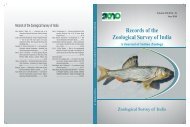Vol. 111 - Part I - Zoological Survey of India
Vol. 111 - Part I - Zoological Survey of India
Vol. 111 - Part I - Zoological Survey of India
You also want an ePaper? Increase the reach of your titles
YUMPU automatically turns print PDFs into web optimized ePapers that Google loves.
RATH & ROY : Crabs and Prawns (Crustacea : Decapoda) <strong>of</strong> Bahuda Estuary, Ganjam, Orissa 55<br />
Family GRAPSIDAE MacLeay, 1838<br />
Genus Metopograpsus H. Milne Edwards, 1853<br />
21. Metopograpsus messor (Forskål, 1775)<br />
1775. Cancer messor Forskål, Desc. Anim., : 88.<br />
1960. Metopograpsus messor : Banerjee, Temminckia, 10 :<br />
174, figs. 4h, I and 5c.<br />
2005. Metopograpsus messor : Dev Roy and Bhadra, State<br />
Fauna Series, 5 : Fauna <strong>of</strong> Andhra Pradesh (<strong>Part</strong> 5)<br />
: 477, pl. 3, fig. 3.<br />
Material examined : 2 ex., Sunapur, 12.12.2006, Coll. :<br />
SR, Reg. No. CR-5744.<br />
Measurements : L-13.0-21.0, W-17.0-27.0.<br />
Distribution : <strong>India</strong> : Andhra Pradesh, Orissa, Tamil<br />
Nadu, West Bengal, Karnataka, Maharashtra, Gujarat<br />
and Andaman and Nicobar Islands.<br />
Elsewhere : Suez Canal, Aden, Red Sea,<br />
Madagascar, Pakistan, Bangladesh, Sri Lanka, Myanmar,<br />
Australia as far as Hawaii.<br />
Remarks : The materials examined and reported<br />
herein comprises <strong>of</strong> juveniles only. It is reported from<br />
Hugli, Mahanadi, Subarnarekha and Vamsadhara<br />
Estuaries (Dev Roy and Nandi, 2009).<br />
Family SESARMIDAE Dana, 1852<br />
Key to the genera <strong>of</strong> the family Sesarmidae from<br />
Bahuda estuary<br />
1. Carapace broader than long, pterygostomian<br />
regions and side walls reticulated,lower border <strong>of</strong><br />
orbit not abnormally prominent......................... 2<br />
— Carapace much broader than long, pterygostomian<br />
regions and side walls not reticulated, lower<br />
border <strong>of</strong> orbit prominent .................... Metaplax<br />
2. Antenna in the orbital hiatus ............................ 3<br />
— Antenna excluded from the orbital hiatus ..........<br />
....................................................... Metasesarma<br />
3. Palm <strong>of</strong> chelipeds with a longitudinal pectinated<br />
crest on its upper part ...................... Episesarma<br />
— Palm <strong>of</strong> chelipeds with 2-3 transverse pectinated<br />
crest on its upper part ....................................... 4<br />
4. Lateral border entire ....................... Parasesarma<br />
— Lateral border with a tooth behind outer orbital<br />
angle .................................................................. 5<br />
5. Upper border <strong>of</strong> movable finger milled with<br />
transverse lamellae, small crab ........ Perisesarma<br />
— Upper border <strong>of</strong> movable finger with longitudinal<br />
crenulate crest separated from one another, large<br />
crab ..................................................... Muradium<br />
Genus Episesarama De Man, 1895<br />
22. Episesarma nederi (H. Milne Edwards, 1853)<br />
1853. Sesarma nederi H. Milne Edwards, Annls. Sci. nat.<br />
(Zool.), sér., 3, 20 : 185.<br />
1957. Sesarma (Sesarma) taeniolata : Chhapgar, J. Bombay<br />
nat. Hist. Soc., 54(3) : 521.<br />
2000. Neoepisesarma (Neoepisesarama) taeniolata : Dev<br />
Roy and Das, Rec. zool. Surv. <strong>India</strong>. Occ. Paper No.,<br />
185 : 95.<br />
2005. Episesarma taeniolata : Dev Roy and Bhadra, State<br />
Fauna Series, 5 : Fauna <strong>of</strong> Andhra Pradesh (<strong>Part</strong> 5) :<br />
485.<br />
2008. Episesarma nederi : Ng, Guinet & Davie, Raffles Bull.<br />
zool., 17 : 220.<br />
Material examined : 1 ex., Sorala, 14.12.2006, Coll. :<br />
SR, Reg. No. CR-5730; 1 ex., Sunapur, 12.12.2006, Coll. :<br />
SR, Reg. No. CR-5743.<br />
Measurements : L-11.0-26.0, W-15.0-29.0.<br />
Distribution : <strong>India</strong> : Andhra Pradesh, West Bengal,<br />
Maharastra, Andaman Islands.<br />
Elsewhere : Pakistan, Mergui, Archipelago, Malay,<br />
Peninsula, Singapore, Indonesia, China, Japan, Thailand.<br />
Remarks : This is a mangrove dwelling species,<br />
generally occurring in the landward fringe. It is reported<br />
to occur in Hugli, Matla, Godavari and Krishna estuaries<br />
(Dev Roy and Nandi, 2009).<br />
Genus Parasesrma De Man, 1895<br />
23. Parasesarma plicatum (Latreille, 1803)<br />
1803. Ocypoda plicata Lattreile, Hist. Nat. Crust., : 47.<br />
1899. Sesarma quadrata : Alcock, J. Asiat. Soc. Bengal,<br />
69(2) : 413.<br />
1957. Sesarma (Sesarma) quadrata : Chhapgar, J. Bombay<br />
nat. Hist. Soc., 54(3) : 520, pl. 16, fig. a-c.<br />
2000. Sesarma (Parasesarma) plicatum : Dev Roy and Das,<br />
Rec. zool. Surv. <strong>India</strong>. Occ. Paper No., 185 : 91.<br />
2005. Parasesarma plicatum : Dev Roy and Bhadra, State<br />
Fauna Series 5: Fauna <strong>of</strong> Andhra Pradesh (<strong>Part</strong> 5) :<br />
483.<br />
Material examined : 4 ex., Keutasunapur, 10.08.2005,<br />
Coll. : AM, Reg. No. CR-5786; 1 ex., Keutasunapur,<br />
22.07.2003, Coll. : SZS, Reg. No. CR-5791.<br />
Measurements : L-12.0-18.0, W-13.0-18.0.<br />
Distribution : <strong>India</strong> : Andhra Pradesh, Orissa,<br />
Pondicherry, Tamil Nadu, West Bengal, Gujarat,
















